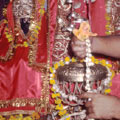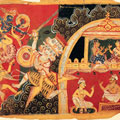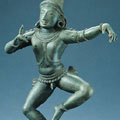|
|
 |
 |
| Ritual Life of the Image |
|
|
Whether an image is housed in a temple, a home, or a roadside shrine, its life is organized around a schedule of worship and around the set of rituals offered to it by devotees (Figure 1). Some rituals have no fixed pattern: devotees perform worship as they pass a shrine or temple on their way to work or school. Other types of worship are associated with particular times of day, especially the beginning and end of the day. In major temples, ritual life can follow a much more complex schedule and take elaborate forms.
In temples maintained by the Vallabha Sampradaya, a sect devoted to Krishna founded by the great teacher Vallabha, images of Krishna are worshiped with an elaborate schedule of ceremonies that corresponds to the daily activities of the human world. The deity is ritually awakened, fed, dressed, and displayed before worshipers. Music and food are presented to delight him, as to an honored guest. Devotees partake of this offered food (prasad), which has become imbued with the grace of God. After his midday meal, Krishna again receives devotees. The priests then retire the image to a private chamber, allowing him rest and the opportunity to escape to the fields, where he takes up his occupation as cowherd and engages in playful and amorous adventures. He is welcomed back to the temple at night by his devotees and fed his evening meal. After receiving visitors again, the deity is ritually retired for the night.
Practices and rites generally follow the forms prescribed by the Agamas and Tantras, texts composed in the first millennium and at the beginning of the second. There are sixteen core elements (upachara) of a worship ceremony (puja) defined in these and other texts, though all elements need not be performed. The sixteen upachara fall into four categories: (1) the deity is invoked in the image; (2) water is offered for washing; (3) the image is literally bathed, dressed, adorned, shown incense and a lamp, and offered food; and (4) the image is shown respect and bid farewell. The waving of a lamp in front of the deity is known as arati. The flame acts as a focal point for the interaction between worshiped and worshiper, a vital part of the visual interchange between them (darshan), which is fundamental to the act of worship. The arati also provides illumination for images in temples that lack electrical lighting.
The recitation of texts is a fundamental part of the rituals surrounding images in worship. Sanskrit texts are recited in some temples, usually by Brahmin priests. The Bhagavata Purana, which tells the story of the divine Krishna, is recited in temples dedicated to this God (Figure 2). A Krishna temple might also feature the Hindi poetry of the 16th-century blind poet-saint Surdas, whose poems devoted to Krishna are beloved in north India. The Tamil saints dedicated to Shiva, known as the Nayanars, and their poetry are greatly revered in Tamil Nadu, in south India (Figures 3 and 4). In that region, their poems occupy a prominent place alongside Sanskrit texts in the orthodox Shiva temples. These poems may be recited by priests or sung by professional singers, but they are also popular among Shiva devotees.
At Bhavani Mandir, a Guyanese Indian temple in the Bronx, the priest is not from the Brahmin caste. One of his services includes a recitation of selections from the Ramcharitmanas, the 16th-century Hindi version of the Ramayana -- the story of Rama -- written by the poet Tulsidas. The service begins with an elaborate ceremony, performed by the priest's wife and another female congregant, worshiping the diverse array of deities displayed on the central altar (Figure 5). The priest then explains, in English, the meaning of the Ramcharitmanas and its relevance. Though he has studied Hindi (and Hindu philosophy), most of his audience does not speak this language, since they are descendants of South Asians brought to the Caribbean and the West Indies by the British as indentured servants in the late 19th century. Throughout the service, Sanskrit texts are recited and Hindi devotional songs (bhajan) are sung in unison by the congregation, with the help of a written transliteration of the Sanskrit and Hindi texts into Roman script. At the end, the congregation shares in a communal meal, and the images are bid farewell until the next time that worship brings them into dynamic interaction with devotees. More elaborate celebrations around sacred images include dance, song, and performances such as the famous Ram-Lila, an enactment of the Ramayana.
< previous
Top |
|
 |
 |
| Click for details |
 |
 |
 |
Fig. 1
|
 |
 |
 |
Fig. 2
|
 |
 |
 |
Fig. 3
|
 |
 |
 |
Fig. 4
|
 |
 |
 |
Fig. 5
|
|
 |


